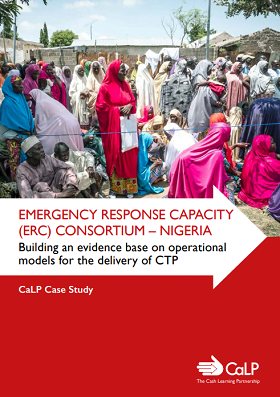Emergency Response Capacity (ERC) Consortium – Nigeria: Building an evidence base on operational models for the delivery of CTP
This case study aims to review and map out how aspects of the Enhanced Response Capacity (ERC) consortium model have influenced key drivers of quality (effectiveness, efficiency and accountability) in the consortium’s Nigeria pilot. Formed at the global level in 2015, the ERC Consortium is comprised of five humanitarian response agencies: Save the Children UK (SCUK), Mercy Corps, the Danish Refugee Council (DRC), the the CALP Network and the United Nations Office for the Coordination of Humanitarian Affairs (OCHA).
The consortium’s objective is to facilitate the uptake of Multipurpose Cash Grants (MPGs) in humanitarian response through a focus on developing technical tools and on activities designed to support the enabling environment for the use of MPGs.
This study methodology uses the CALP Network’s operational models analytical framework for the delivery of cash transfer programming (CTP) to identify and explore aspects of the ERC Consortium model that have had an influence on quality in the Nigeria pilot. The overall aim of this study is to provide recommendations on the future evolution of the ERC Consortium and to contribute to a growing evidence base on operational models.



